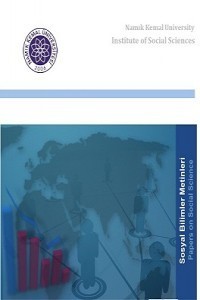GELİŞEN PİYASALARDA SÜRÜ DAVRANIŞI: BİST ÖRNEĞİ
CSSD, CSAD, Sürü Davranışı, Finansal Kriz, BİST
HERDING BEHAVIOUR IN EMERGING MARKETS: EVIDENCE FROM BIST
CSSD, CSAD, Herd Behaviour, Financial Crisis, BIST,
___
- Banerjee, A. V. (1992). A Simple Model of Herd Behaviour. The Quarterly Journal of Economics, 107(3), 797–817.
- Bikhchandani, S. & Sharma, S. (2000). Herd Behaviour in Financial Markets. IMF Economic Review, 47(3), 279-310.
- Cajueiro, D. O. & Tabak, B. M. (2009). Multifractality and Herding Behaviour in the Japanese Stock Market. Chaos, Solitons & Fractals, 40(1), 497–504.
- Chang, E. C, Cheng, J.W. & Khorana, A. (2000). An Examination of Herd Behaviour in Equity Markets: An International Perspective. Journal of Banking & Finance, 24(10), 1651–1679.
- Chevalier, J. & Ellison, G. (1999). Career Concerns of Mutual Fund Managers. The Quarterly Journal of Economics, 114(2), 389–432.
- Chiang, T. C. & Zheng, D. (2010). An Empirical Analysis of Herd Behaviour in Global Stock Markets. Journal of Banking & Finance, 34(8), 1911–1921.
- Choe, H., Kho, B. C. & Stulz, R. M. (1998). Do Foreign Investors Destabilize Stock Markets? The Korean Experience in 1997. Journal of Financial Economics, 54(2), 227-264.
- Christie, W. G. & Huang, R. D. (1995). Following the Pied Piper: Do Individual Returns Herd around the Market?. Financial Analysts Journal, 51(4), 31–37.
- Demirer, R., Gubo, D. & Kutan, A. M. (2007). An Analysis of Cross-Country Herd Behaviour in Stock Markets: a Regional Perspective. Journal of International Financial Markets, Institutions and Money, 3(1), 123–142.
- Demirer, R. & Kutan, A. M. (2006). Does Herding Behavior Exist in Chinese Stock Markets?. Journal of international Financial markets, Institutions and Money, 16(2), 123-142.
- Doğukanlı, H. & Ergün, B. (2015). BIST’te Sürü Davranışı: Hwang ve Salmon Yöntemi ile Bir Araştırma. Finans Politik & Ekonomik Yorumlar, 52(603), 7–24.
- Doğukanlı, H. & Ergün, B. (2011). İMKB’de Sürü Davranışı: Yatay Kesit Değişkenlik Temelinde Bir Araştırma. Dokuz Eylül Üniversitesi İşletme Fakültesi Dergisi, 12(2), 227–242.
- Gelos, R. G. & Borensztein, E. (2000). A Panic-Prone Pack? the Behaviour of Emerging Market Mutual Funds. IMF Working Papers, 2000(198), International Monetary Fund.
- Hwang, S. & Salmon, M. (2004). Market Stress and Herding. Journal of Empirical Finance, 11(4), 585–616.
- Kapusuzoglu, A. (2011). Herding in the Istanbul Stock Exchange (ISE): A Case of Behavioural Finance. African Journal Of Business Management, 5(27), 11210-11218.
- Kim, W. & Wei, S. J. (2002a). Foreign Portfolio Investors Before and During a Crisis. Journal of International Economics, 56(1), 77-96.
- Kim, W. & Wei, S. J. (2002b) “Offshore Investment Funds: Monsters in Emerging Markets?” Journal of Development Economics, 68(1), 205–224.
- Gavriilidis, K. & Kallinterakis, V. (2021). Herding in Imperial Russia: Evidence from the St. Petersburg Stock Exchange (1865–1914), Journal of Behavioural Finance, 1-15.
- Lakonishok, J., Shleifer, A. & Vishny, R. W. (1992). The Impact of Institutional Trading on Stock Prices. Journal of Financial Economics, 32(1), 23–43.
- Mobarek, A., Mollah, S. & Keasey, K. (2014). A Cross-Country Analysis of Herd Behaviour in Europe. Journal of International Financial Markets, Institutions and Money, 32, 107–127.
- Wang, D. (2008). Herd Behaviour Towards the Market Index: Evidence from 21 Financial Markets. IESE Business School Working Paper, 776, 1-41. Erişim Tarihi: 17.01.2022, https://papers.ssrn.com/sol3/papers.cfm?abstract_id=1316783.
- ISSN: 1308–4453/1308–4895
- Yayın Aralığı: Yılda 2 Sayı
- Başlangıç: 2008
ÜLKE KREDİ DERECELENDİRMENİN MEKÂNSAL ANALİZİ: GIPSI ÜLKELERİ
GELİŞEN PİYASALARDA SÜRÜ DAVRANIŞI: BİST ÖRNEĞİ
Kerim Eser AFŞAR, Utku AKSEKİ, Zakayo Samson KİSAVA
Fatma Sema SEKBAN, Mine TOPÇUBAŞI
EKONOMİK YAPISAL DEĞİŞİM KAVRAMI ÜZERİNE BİR İNCELEME
